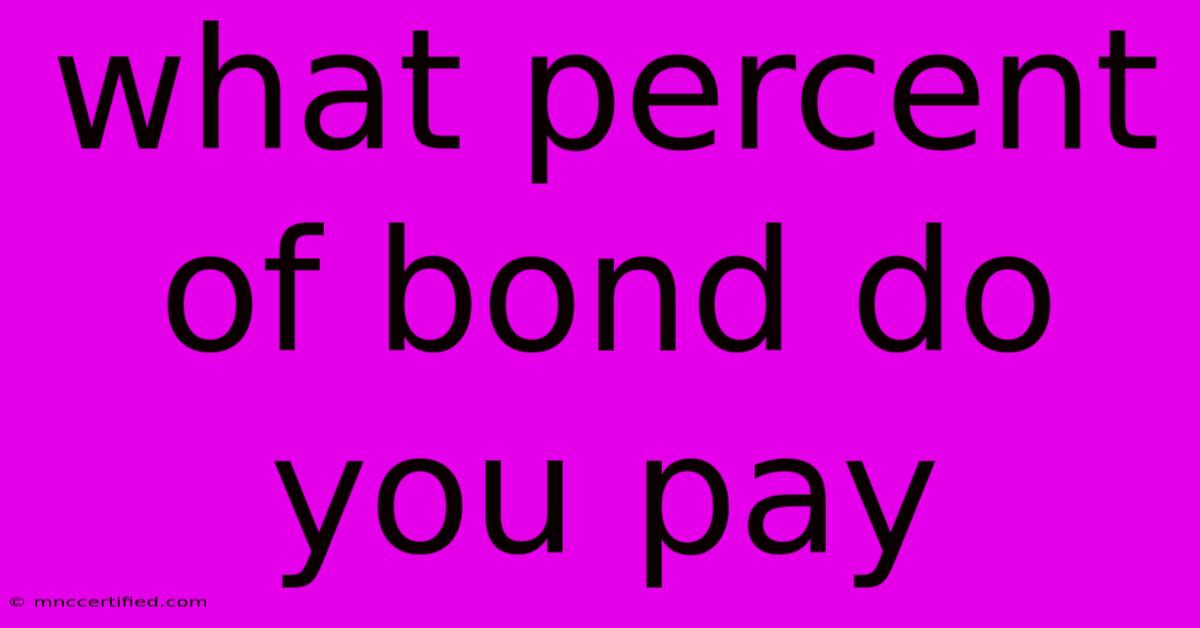What Percent Of Bond Do You Pay

Table of Contents
What Percentage of a Bond Do You Pay? Understanding Bond Yields and Returns
Understanding how much you "pay" for a bond can be confusing. You don't directly pay a percentage of the bond's face value upfront like you might with a stock. Instead, you pay a price that reflects the bond's current market value, which is influenced by factors like interest rates and the bond's characteristics. Let's break down the key concepts to clarify what you're actually paying and earning.
The Price You Pay: It's Not Always Face Value
Bonds have a face value (also called par value), which is the amount the issuer will repay at maturity. For example, a bond with a face value of $1,000 means the issuer will pay you $1,000 when the bond matures. However, you rarely buy a bond at its face value. The price you pay depends on several factors:
- Interest Rates: If prevailing interest rates rise after a bond is issued, the bond's market price will typically fall. This is because newer bonds offer higher yields, making older bonds less attractive. Conversely, if interest rates fall, the bond's price generally rises.
- Credit Rating: Bonds issued by companies or governments with higher credit ratings are considered less risky and therefore command higher prices. Lower-rated bonds carry more risk and will typically sell at a discount.
- Time to Maturity: The closer a bond is to maturity, the less its price fluctuates based on interest rate changes. Bonds nearing maturity will generally trade closer to their face value.
- Call Provisions: Some bonds have call provisions that allow the issuer to redeem the bond before maturity. This can impact the price, especially if interest rates have fallen since the bond was issued.
Understanding Yield: Your Return on Investment
Instead of focusing on the percentage of the face value you pay, it's more helpful to understand the yield of a bond. Yield represents the return you receive on your investment. There are several types of yields:
-
Current Yield: This is the annual interest payment divided by the current market price. It gives you a sense of the annual return based on the price you paid. For example, a bond with a $50 annual interest payment and a market price of $1,000 has a current yield of 5%.
-
Yield to Maturity (YTM): This is the total return you'll receive if you hold the bond until maturity. It accounts for the difference between the purchase price and the face value, as well as the interest payments received over the life of the bond. YTM is a more comprehensive measure of your return.
-
Yield to Call (YTC): If a bond is callable, the YTC calculates your return if the issuer calls the bond before maturity.
Calculating Your Return: A Practical Example
Let's say you buy a $1,000 face value bond for $950. It pays an annual interest of $50.
- Current Yield: $50 (annual interest) / $950 (market price) = 5.26%
- Yield to Maturity (YTM): This requires a more complex calculation considering the time to maturity and the difference between the purchase price and face value. You can use online bond calculators to determine the YTM.
In essence, you're not paying a percentage of the bond; you're paying a price that determines your yield. Focus on the yield (current yield or YTM) to understand your potential return on investment. The price you pay is a reflection of market conditions and the bond's specific characteristics.
Finding Bond Information
To research bonds and find their current prices and yields, you can consult resources like:
- Financial news websites: Major financial news sources often provide bond market data.
- Brokerage platforms: Most online brokerage accounts offer bond quotes and analysis tools.
- Bond rating agencies: Agencies like Moody's, S&P, and Fitch provide credit ratings for bonds, which help assess risk.
Understanding bond pricing and yields is crucial for making informed investment decisions. Consult with a financial advisor if you need personalized guidance.

Thank you for visiting our website wich cover about What Percent Of Bond Do You Pay. We hope the information provided has been useful to you. Feel free to contact us if you have any questions or need further assistance. See you next time and dont miss to bookmark.
Featured Posts
-
Jennifer Lawrence Next Insurance
Nov 22, 2024
-
Aladdin Bail Bonds In Las Vegas
Nov 22, 2024
-
Baron Investment Conference 2023
Nov 22, 2024
-
Giants Qb Jones Regret Over Losses Future
Nov 22, 2024
-
India Vs Australia 1st Test Live Score
Nov 22, 2024